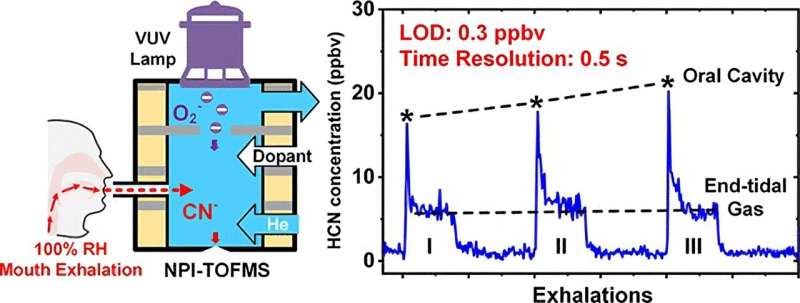Researchers monitor real-time single-breath exhaled hydrogen cyanide profiles

Hydrogen cyanide (HCN) featured with high volatility and high adsorption is a common toxic and hazardous gas. Traces of HCN are also found in human exhaled breath. Unusual high HCN concentration in the breath of cystic fibrosis (CF) patients is associated with Pseudomonas aeruginosa (PA) infection. Therefore, the development of a highly sensitive online HCN measurement in exhaled breath can enable rapid screening for PA infection in CF patients.
Recently, a research group led by Prof. Li Haiyang from the Dalian Institute of Chemical Physics (DICP) of the Chinese Academy of Sciences (CAS) has developed a flow-assisted photoionization mass spectrometry method for profiling hydrogen cyanide in exhaled breath.
The study was published in Analytical Chemistry on April 4.
“HCN is easily soluble in water and highly adsorbed on device surfaces, so sensitivity and response speed are main challenges for directly measuring HCN in exhaled breath at high humidity presents,” said Prof. Chen Ping, co-corresponding author of this study.
The researchers developed a method by utilizing a self-developed atmospheric pressure negative photoionization time-of-flight mass spectrometer instrument and improved the sensitivity and time resolution of direct HCN measurements in exhaled breath. This method enabled real-time tracking of HCN concentrations in a single exhaled breath, which could provide an effective means for early screening of CF patients with PA infection.
They proposed to use helium shield gas within the mass spectrometry ionization source. This approach reduced the effect of high humidity on ionization, improved ion transport efficiency, and thus enhanced HCN detection sensitivity.
Moreover, they improved the sampling system by shortening the sampling line and adding a gas purging process to effectively reduce HCN adsorption residue and improve time resolution. This method achieved a limit of detection of 0.3 ppbv and a resolution time of 0.5 s.
By utilizing this method, the researchers tracked the changes in the single exhaled HCN profiles of volunteers before and after gargling. The resulting profiles clearly showed an early peak and a stable end-tidal plateau, representing the concentration of the oral cavity and end-tidal gas, respectively.
“The new method demonstrated good resistance to interference and high accuracy in HCN quantification. It has potential applications in the detection of PA infection in CF patients,” said Prof. Li.
More information:
Yuxuan Wen et al, Online Detection of HCN in Humid Exhaled Air by Gas Flow-Assisted Negative Photoionization Mass Spectrometry, Analytical Chemistry (2023). DOI: 10.1021/acs.analchem.2c05603
Citation:
Researchers monitor real-time single-breath exhaled hydrogen cyanide profiles (2023, April 28)
retrieved 28 April 2023
from https://phys.org/news/2023-04-real-time-single-breath-exhaled-hydrogen-cyanide.html
This document is subject to copyright. Apart from any fair dealing for the purpose of private study or research, no
part may be reproduced without the written permission. The content is provided for information purposes only.
For all the latest Science News Click Here
For the latest news and updates, follow us on Google News.

